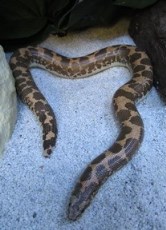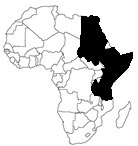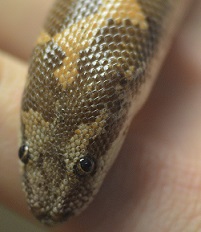Kenyan Sand Boa
Gongylophis colubrinus
- Habitat: Semi-arid environments to scrub savannah
- Range: Egypt, Niger, Somalia, Ethiopia, Sudan, Kenya, and northern Tanzania
- Natural Diet: Small mammals, small birds, small
reptiles
- Status in the Wild: Common
All about the Kenyan
Sand Boa
Kenyan Sand Boas are
small-sized snakes that are dark brown in color with light brown
blotches and cream colored underbellies. Their coloring camouflages
very well with their surroundings and helps protect them especially
since they spend a considerable amount of time hiding in the sand.
For this reason, their eyes and nostrils are located higher up on
their heads allowing them to peer along the sand surface to check
for both predators and prey. Females are predominantly larger than
males reaching three feet in length while males are around two feet.
They weigh around two pounds.
Diet/ Habitat/ Range
Kenyan Sand Boas are
found in dry desert, semi-desert and Savannah type habitat in
north-eastern and eastern Africa e.g. Egypt, Ethiopia, Eritrea,
Somalia, and Sudan. They are obligate carnivores feeding
predominantly on meat including small mammals, small birds, small
reptiles, and amphibians, insects, and arachnids.
Behavior
Kenyan Sand Boas are
terrestrial and are active during the night(nocturnal). Unlike
mammals, they cannot thermoregulate and are often seen basking in
the sun to warm up. They are solitary by nature pairing only during
the breeding season. Sand boas are ambush predators. They ambush and
capture their prey, pulling them under the sand, constricting and
incapacitating them before feeding on them.
Reproduction
Female Kenyan Sand Boas
lay their eggs in winter and spring. They are ovoviviparous which
means that although the young develop inside an egg within the
female, they are delivered live. Females are known to deliver 10 to
20 young boas which usually are eight to 10 inches long.
 The Kenyan sand boa spends a considerable proportion of time buried in the soil
The Kenyan sand boa spends a considerable proportion of time buried in the soil

Distributional range in Africa

They have tapering heads with their eyes positioned almost on top of
their heads to give them a perfect view of what is above them when
they are buried in the soil

